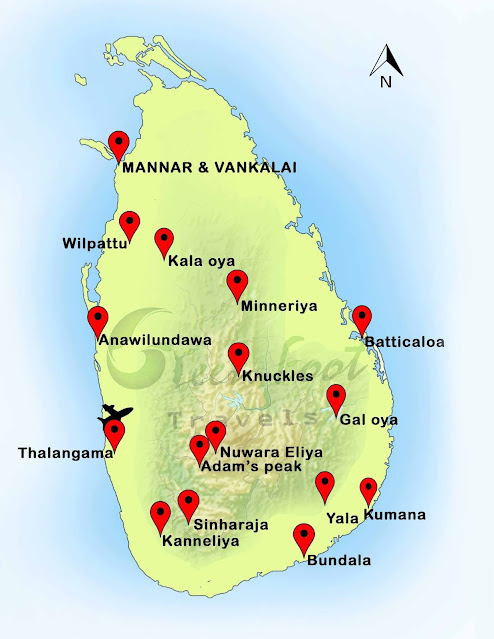Birding in Sri Lanka for Beginners
He has done a comparative analysis between islands that are south of the equator and also popular as wildlife tourist destinations.
So where does one start? With the enthusiasm to seek and see. Why do I say this? Watching wildlife, in general, requires patience -- so without enthusiasm to keep you engaged, you will soon give up! Having said that, Sri Lanka offers both the casual and the experienced birder a different experience. In the major cities alone, you are treated to at least 30 species of birds, ranging from cackling Babblers to the sweet melody of a Magpie Robin. Dawn and dusk come alive with songs and calls of all sorts.
“Sri Lanka has 33 species of endemic birds, largely confined to its lowland and highland wet zones. The number of endemic birds per unit area is high compared to Borneo (52 species) and Madagascar (106 species with a 51% endemism rate) but on par with New Guinea (320 species). A further fifty-plus species of birds found in Sri Lanka are shared only with India (subcontinental endemics). Furthermore, it has a special avian spectacle in the Sinharaja Bird Wave. This is the longest continuously studied mixed-species bird flock phenomenon in the world, with the largest average number of individuals in a flock from such studies, and offers the most stable viewing of usually fast-moving tropical bird waves. The island is the last stop on the Central Asian flyway and a million migrant shorebirds were counted one February in a land-based census which suggests that Viddathalthivu in the Mannar region may even be the most important integral site for migrants on the Central Asian flyway.”
Equip yourself with a simple guide, such as this [2], and pair it up with a pair of binoculars. Our recommendation would be to use an 8x40 or 10x50, with the latter recommended for shorebirds. A pair that has served me well over the years is a Pentax Papilio 8.5x21 Binocular, which is lightweight and is versatile for watching both forest and shorebirds, as well as an occasional insect at close range. The focusing capability at close or long-range is superb. If you’re carrying a camera, I would recommend a lightweight pair of binoculars such as this to lessen the burden, but if you intend to only carry a pair of binoculars, then going for a bulkier, sharper pair is recommended, to ensure you capture all the colorful details.
In the city, you are greeted by many bird species and some of the more common ones include Yellow-billed Babbler (commonly referred to as the Seven Sisters, as they tend to flock together in groups of 7), Rose-ringed Parakeet (commonly seen nesting in holes made by woodpeckers), Black-rumped Flameback (endemic woodpecker), Brown-headed Barbet, Greater Coucal, Magpie Robin, Red-vented Bulbul (often makes nests in light-fixtures), Common Crow, Rock Pigeon (abundant and seen nesting in tall buildings), White-throated Kingfisher (a loud, medium-sized kingfisher with a diet consisting of insect, invertebrates, and mice!), Black-hooded Oriole, Shikra (small raptor with an appetite of lizards and small birds), Eagles, Kites, Herons (Pond, Grey, Purple, Little Green, Black-crowned), Egrets (Cattle, Little, Intermediate, Great), Bitterns (Black, Yellow, Cinnamon) and Sunbirds (Purple, Purple-rumped).
It is recommended that you start early -- as early as six in the morning if you want to observe more species and behavior. Again, from about four in the evening, you will see the birds getting busy before roosting.
Sri Lanka is blessed with varying terrains. An island with central highlands, which means that from the coastline to the hills, the bird species vary as well. The coastline attracts flamingoes, ducks, and other waders. Going inland, you will see that bird species are largely segmented into dry arid zones, wet zones, and hill countries. The wet zone areas and the montane forests of the hill country contain most of the endemic species. The dry zone areas, although fewer endemic species, still boasts of many eye-catching species such as the Blue-faced and Sirkeer Malkohas. Yala is a coastal dry zone wildlife park teeming with 200+ species of birds during the migrant season -- but overlooked due to its popularity as a hotspot for leopards and big game.
[1] - http://makinibushcamp.com/resources/Sri-Lanka-Super-Rich-Wildlife-2013-07-LR.pdf
[2] - https://www.amazon.com/Birds-Lanka-Pocket-Photo-Guides/dp/1472969944



.jpg)

Comments
Post a Comment